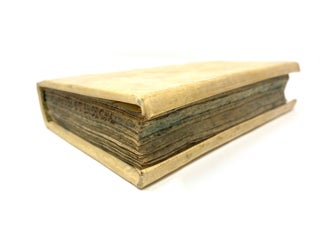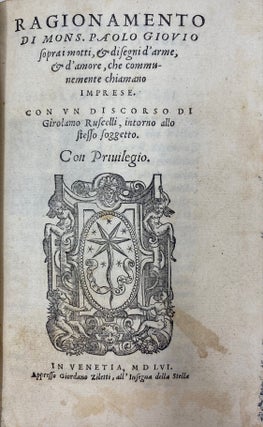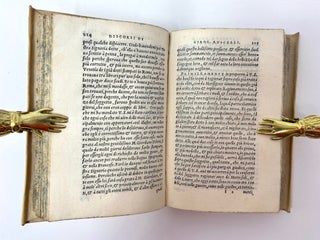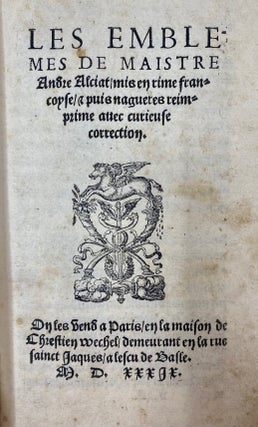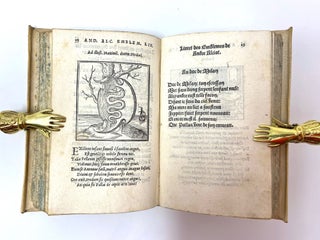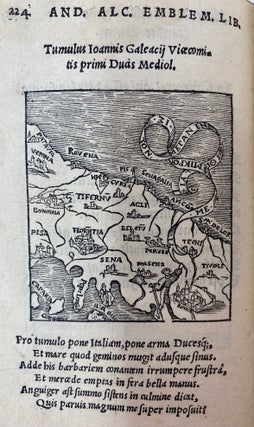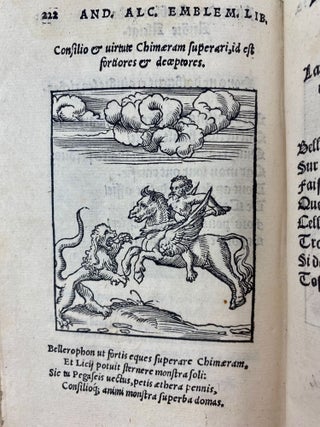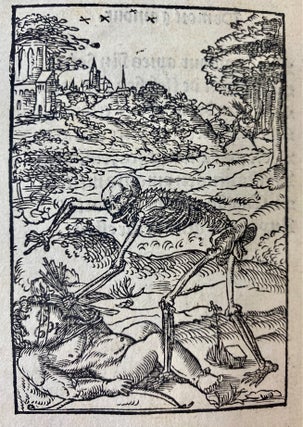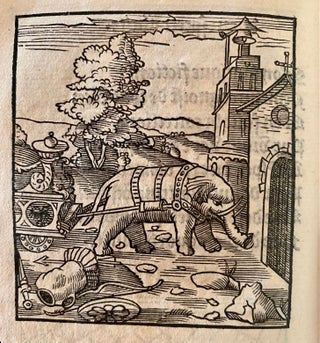Ragionamento di Mons. Paolo Giovio /Les Emblemes de Maistre Andre Alciat
Venetia / Paris: Giordano Ziletti, all'Insegna della Stella /Chrestien Wechel, 1556 / 1539. Parchment. First edition of magnificent iconographic apparatus of emblems, allegories and magic formulas
Volume I - Ragionamento di Mons. Paolo Giovio sopra i motti, et disegni d'arme, et d'amore, che communamente chiamano imprese. Con un discorso di Girolamo Ruscelli, intorno allo stesso soggetto.
In Venetia, appresso Giordano Ziletti, all'Insegna della Stella – 1556
Pp 236
(BOUND WITH:)
Volume II - Andrea Alciati – Les Emblemes de Maistre Andre Alciat, mis en rime francoyse, et puis nagueres reimprime auec curieuse correction.
On les vend a Paris, en la maison de Chrestien Wechel 1539
Paolo Giovio
Andrea Alciati
Pp 245
15,5 x 9,5 cm
Two works bound in one volume. Altogether more than 100 allegorical representations of woodcut emblems. Interesting and curious juxtaposition of works in some ways similar: the first edition of the Ragionamento sulle imprese di Giovio e del Discorso di Ruscelli - always on the same theme – and the very rare Latin-French edition of the Emblemata of Alciati.
This is the re-edition, also by Wechel, of the first (French) of 1536, which includes the magnificent woodcut apparatus attributed to Jean Mercure Jollat, composed of more than one hundred allegorical and symbolic woodcuts.
Emblemata (Emblematum liber) by Andrea Alciato is the founding work of an entire literary genre. The first book of Emblems, which will have considerable popularity in the humanistic and Renaissance culture of the whole of Europe.
One of the most complete editions of the famous work of the renowned humanist.
The fully illustrated scenes are often full of action and include many fascinating and revealing details, not only of the mythical narrative, but also of the customs, architecture, events and tools of everyday life of the period.
The combination of allegorical images and epigrams that became known as the “book of emblems” was made popular by the Milanese jurist Andrea Alciati (1492–1550), who created a real ‘genre’ that was then imitated and reproduced until the 20th century: each emblem appears on a separate page, with title and motto next to the image and moral explanation next to it.
The books of emblems combined images and text to describe a social moral truth so that the reader’s memory would grasp it, not as a formula, but as a real visual experience. This unique category of illustrated books had a strong influence on both contemporary literature and the fine arts. The French lexicographer Jean-Pierre Nicéron observed that a person's education was not complete without knowledge of Alciati’s book.
The first edition dates back to 1531, printed by Chrestien Wechel in Augsburg, but in the 1840s, the main production of books of emblems moved to Lyon, where Guillaume Rouille, Jean de Tournes and Macé Bonhomme produced competing editions cfr. D.B.It. II, p. 72); It is also sought for the presence of emblem no. LXXX, which depicts a woman defecating in a vase of gold, stigmatising same-sex relationships.
Extremely vulgar ("Adversus naturam peccantes"), almost always missing in previous editions.
The word "emblemata" is the plural of the Greek word "emblema", a term that indicates a decorative element, a mosaic or an ornament: in its preface to Peutinger, Alciato describes his emblems as a learned fun, a pastime for humanists imbued with classical culture.
Alciato's work had thousands of imitations in all European vernacular languages: profane, religious or amorous, the books of emblems were an integral part of European culture for two centuries.
Binding in 18th-century rigid full parchment, with gold title on leather label applied to the spine and, handwritten, to the lower edge, sprayed fronts, pp. (2b) + (16) + 236 (232 real), 245 + (3b); title pages of both works are slightly stained, rare foxing in the first work. Ragionamento: woodcut on the title page (allegory of the star with the motto "inter omnes"), some woodcut talking caps, text in italics. Emblemes: title page almost entirely in Gothic characters, with a beautiful typographic woodcut print representing Pegasus, woodcut caps, introduction in French Gothic characters, followed by a Latin text in italics with French translation also in Gothic characters. good. Item #30
Price: $1,450.00


